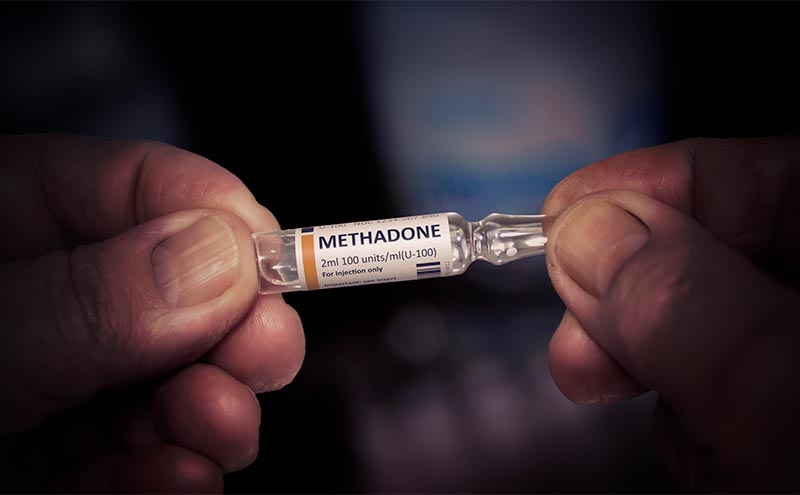
Pediatric Methadone Ingestion
Case Report
A 21 month-old female with a history of prematurity (26 weeks, 6 days), respiratory distress syndrome and facial hemangiomas presented to the Emergency Department (ED) with acute onset of altered mental status and respiratory depression. Patient was found on the morning of presentation by her mother playing at the sink with an open bottle of liquid methadone (110mg of 10mg/mL solution). The medication had been spilled into the sink and was also noted on the patient’s shirt and chest. The patient’s mother watched her for approximately 30 minutes prior to calling 911 for increased sleepiness. On EMS arrival, the patient was treated with 1mg intranasal naloxone for respiratory depression with good effect. She was brought to a community ED and required an additional 2mg of intranasal naloxone for recurrent respiratory depression prior to transfer to a tertiary care center. A protective concern form was filed and patient was transferred to our pediatric ED for further care and management.
On arrival to the tertiary care center, the patient’s initial vital signs were a temperature of 36.7 Co, heart rate of 124 beats/min, respiratory rate of 24 breaths/min, blood pressure 111/69 mmHg, and oxygen saturation of 98% on room air. On exam, she was initially noted to be alert and awake and in no acute distress. She had miotic pupils, approximately 2-3 mm bilaterally. Her respiratory effort was normal. She was placed on telemetry, continuous pulse oximetry, and end tidal CO2 monitoring. Approximately 4 ½ hours after the initial exposure, the patient received a third dose of naloxone (1mg of naloxone IV) for respiratory depression, as evidenced by rising end-tidal CO2 levels and hypoxia. An ECG showed sinus tachycardia with a ventricular rate of 151, QRS 52, and QTc 412. Lab testing for xenobiotics included an undetectable serum acetaminophen level, undetectable salicylate level, and an undetectable ethanol level. Urine immunoassay screening for amphetamines, cocaine, opiates, cannabinoids, oxycodone, fentanyl, barbiturate, buprenorphine, and benzodiazepines were negative. Her urine methadone screen was presumed positive. Her complete blood count showed a white blood cell count 12, hemoglobin 12.5, hematocrit 37.0, and platelet count 313. Complete metabolic panel showed sodium 139 mmol/L, potassium 4.3 mmol/L, chloride 108 mmol/L, bicarbonate 19 mmol/L, BUN 14 mg/dL, serum creatinine 0.22 mg/dL, serum glucose 77 mg/dL, alkaline phosphatase 300 U/L, ALT 15 U/L, AST 37 U/L, total bilirubin 0.3 mg/dL, and calcium of 9.3 mg/dL.
Patient was subsequently admitted to the Pediatric Intensive Care Unit (PICU) for ongoing monitoring. She was monitored in the PICU for 66 hours and required an additional 7 doses of naloxone prior to hospital discharge. Absent medical intervention, this methadone exposure would have likely been fatal. At 9.6kg, even 1mL (10mg) of this formulation is sufficient to cause fatal CNS and respiratory depression in this patient.1,2
Pediatric Methadone Ingestions
Many unintentional pediatric methadone toxicities occur from exposure to the liquid form as it is easier for children to obtain and ingest.2-4 Pediatric methadone ingestions are becoming more frequent in the US with the expansion of opioid maintenance treatment (OMT) programs for outpatient care of adult chronic pain and opioid dependence. A retrospective study of methadone and buprenorphine ingestions from Acadia hospital in Bangor, Maine found that the number of adult patients receiving outpatient OMT increased from 10 to 912 patients during 2001-2009; this reflected the 7-11 fold rise in the total number of patients on OMT in the neighboring counties.1 The authors also found a statistically significant, three-fold increase in the prevalence of pediatric methadone and buprenorphine ingestions over this time period (5 cases in the first 5 years and 17 cases in the subsequent 5 years).1 A parallel relationship can be appreciated between the prevalence in pediatric ingestions and the number of adult patients on OMT. In this case, the patient was exposed to methadone prescribed to her mother as part of a take-home program for OMT. The patient was able to reach the unsecured bottle of methadone stored at the bathroom sink by standing on a stool.
Methadone is a long-acting mu opioid receptor agonist, which is plasma protein-bound with effects similar to morphine and has an 85-90% bioavailability in body tissues. Methadone’s extended duration half-life of 24-36 hours helps to suppress withdrawal symptoms in opioid-dependent individuals. Comparatively, other opioid agonists have shorter half-lives including oxycodone at 3-6 hours and hydromorphone at 3 hours. Accumulation of this synthetic drug causes sedation and respiratory depression, and rarely hyperglycemia, pulmonary and cerebral edema in children.1,5 Unlike other opioid agonists, methadone had potassium channel blocking effects that can cause QTc prolongation and cardiac dysrhythmias. Methadone exposure and toxicity in children can be delayed and prolonged. After possible exposure, even well-appearing children require 24 hours of observation as they have a high risk of death with early discharge.1
Naloxone is the preferred treatment for respiratory depression in opioid overdose. With the potential of prolonged effects from methadone, a naloxone infusion may be indicated for substantial overdoses. In opioid-dependent individuals, naloxone infusions are typically started at two-thirds of the total dose required for initial reversal of respiratory depression and titrated as needed based on the clinical status of the patient. For opioid naïve patients, less attention is needed to limit the initial infusion rate as precipitating opioid withdrawal is not a concern. Alternatively, repeat bolus dosing of naloxone can be given as needed for respiratory depression.5 Following discontinuation of the infusion or the last naloxone dose, these patients still required prolonged observation (at least 6 hours) to ensure no further reversal is needed given the relatively short half-life of naloxone.
Conclusions
As emergency physicians, patient and parent education on safe medication storage and use should be emphasized with every pediatric methadone/buprenorphine exposure. Recent studies have shown that place of storage and proper container labeling are associated with child access to these drugs.4 In one study of pediatric methadone exposures, 37% of cases had methadone stored in the kitchen refrigerator and only 18% of cases was the methadone kept in a clearly labeled container.3 Clinicians who prescribe methadone/buprenorphine or who take care of patient on OMT should regularly check-in with their patients regarding safe medication storage.
References
- Martin TC and Rocque M. Accidental and Non-Accidental Ingestion of Methadone and Buprenorphine in Childhood: A Single Center Experience, 1999-2009. Current Drug Safety, 2011, 6, 12-16
- Lewington LE, Shaffer C, Ornstein AE. Paediatric methadone ingestions: An under-recognized form of child maltreatment? Paediatric Child Health. 2014;19(3):139–140. doi:10.1093/pch/19.3.139
- Kashani P, Safari S, Hatamabadi H, Arhami Dolatabadi A, Manouchehrifar M, Dokht Tabrizi M. Characteristics of Methadone Intoxicated Children Presenting to Emergency Department; a Cross Sectional Study. Emerg (Tehran). 2017;5(1):e80. doi:10.22037/emergency.v5i1.18780
- Hosseininasab A, Vahidi A, Bagheri-Charouk F. Predisposing Factors for Methadone Poisoning in Children Hospitalized at Kerman Afzalipour Hospital, Iran. Addict Health 2016; 8(1): 61-6.
- Tiras, Sinan et al. Nonketotic Hyperglycemic Coma in Toddlers After Unintentional Methadone Ingestion. Annals of Emergency Medicine, Volume 48, Issue 4, 448 – 451
Stephen Allegra, MD MPH
University of Massachusetts, Emergency Medicine Residency

